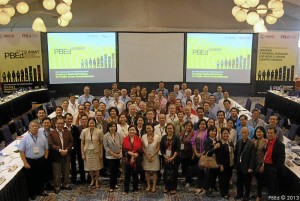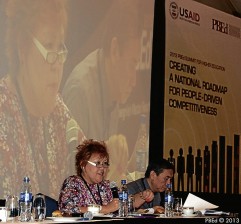
ALL TOGETHER NOW Forty university or college presidents plus heads of higher education associations, professional organizations and industry leaders under one roof
If all goes well, by 2015, the 11 member countries of the Association of Southeast Asian Nations (Asean), including the Philippines, will have transformed themselves into a “borderless” region where there is free movement of capital, investment, goods, services and skilled labor.
What does this mean for our students who will be graduating from universities in a few years and will then be looking for work?
First, the good news: Filipinos will be able to apply for jobs in any Asean country without the need for a working visa. Asean 2015 will open up to qualified applicants from member countries all kinds of employment within member countries, not just the domestic helper jobs that our Asian neighbors are currently dangling before Filipinos, be they college graduates or not.
Now, the bad news: Filipinos will be competing with job-seekers from other countries in the region who may be better educated and prepared for what the times and the industries will need.
“At present, if a Singaporean and a Filipino apply for the same position, believe me, the Singaporean will get the job because of their very high standards of education,” said Sen. Edgardo Angara on one occasion.
The same scenario is in the crystal ball for most Filipino graduates unless the quality of education improves—from the ground up.
“If we don’t do something we’re really going to be sunk,” said Juan Miguel Luz, dean of the Center for Development Management at Asian Institute of Management (AIM).
Game-changer
Clearly, Asean 2015 is a game-changer for Philippine education, not unlike the K to 12 reform program.
This much the 80 academe, industry and government leaders acknowledged when the Philippine Business for Education (PBEd) gathered them recently for its 2013 Higher Education Summit at the Shangri-La Mactan Hotel and Resort in Cebu.
PBEd was formed in 2006 by business leaders alarmed by the inferior quality and quantity of our graduates. The distressing statistics supported the business community’s concerns. For instance, only two out of 100 high school graduates were qualified to enter college. Remediation lessons on basic skills were being given on the job site, said PBEd president Chito Salazar, and training cost was growing.
Many of the problems were deeply rooted in elementary and secondary education. To begin to address them, PBEd pushed hard for the adoption of the K to 12 program to reform basic education by adding kindergarten and converting the six grade levels in elementary school plus the four years of high school (for a total of 10 years) into a 12-grade ladder. Supposedly built into the longer school stay are changes in the curriculum to include a focus on lifelong skills and teacher training.
The K to 12 program has been ratified by both houses of the legislature and is very likely to be signed soon into a law by President Aquino.
“Basic education [K to 12] covered a lot of our problems but not all,” said Salazar. “You hear it from media all the time. There is a mismatch, there is a mismatch.”
He was referring to the mismatch between the skills needed by business and industries and the skills of graduates produced by higher education institutions (HEIs).
To address this particular concern and with the support of the United States Agency for International Development (USAID) Philippines, PBEd embarked on the Higher Education and Productivity Project.
CHEd chair Patricia Licuanan, USAID Phil. mission director Gloria Steele and PBEd chair Ramon del Rosario Jr.
As a first step, it sought consultations and broke down the mismatch problem into five key areas of concern so, as Salazar put it, “we don’t come here with the whole universe.”
The first key area is quite a mouthful: The SUCs (state universities and colleges), the LUCs (local universities and colleges), private HEIs, government and the role of each.
The other key areas are: Matching industry demands with higher education supplies; course content to bridge the industry and the curriculum; creating a world-class faculty; and quality control and assurance.
PBEd next held workshops with representatives from local, state and private HEIs, as well as industry and government leaders whose ideas and actions could impact on education.
Roadmap
And then, more recently, PBEd organized the Mactan summit to create “a roadmap for people-driven competitiveness.”
With such a wild maze to negotiate, the summit had to play another role, which was to shepherd university and college presidents, industry associations, professional boards, the Commission on Higher Education (CHEd) and legislators as one flock with common goals.
“The time for big dreams, ambitious goals and massive change is now,” said PBEd chair Ramon del Rosario on the summit’s first day.
AIM’s Dr. Edilberto de Jesus presented the global and regional trends in higher education. Lawyer Emerico de Guzman of the National Competitiveness Council talked about the state of our competitiveness in the context of national growth and development. University of the Philippines professor Maria Serena Diokno briefed the participants on college readiness and the value of general education.
On Day 2, participants were divided into groups so they could formulate concrete recommendations for improving academe-industry linkages, curriculum and faculty development and quality assurance.
The proceedings went smoothly and the level of discussion was rational. Not at all surprising in group composed of whip smart industry leaders and higher education VIPs, including the presidents of the Top 3.
The PBEd chair had, in fact, personally hosted a dinner for Dr. Alfred Pascual, Fr. Jose Ramon Villarin, SJ, and Br. Ricardo Laguda, FSC, presidents of the University of the Philippines (UP), Ateneo de Manila University (ADMU) and De La Salle University (DLSU), respectively. That was when Salazar said he asked them to get involved because “kahit paano, we look up to your leadership and we are trying to encourage a sectoral view.”
United sector
PACU’S Patricia Lagunda, JRU’s Vince Fabella, DLSU’s Br. Ricky Laguda, FSC, ADMU’s Fr. Jet Villarin, UMak’s Tommy Lopez, Pasuc’s Serafin Ngohayon and PBEd’s Chito Salazar
By the summit’s end, the participants, acting as one sector, had several recommendations, which included forming an academe-industry council, communicating the global value of a Filipino graduate, strengthening the coordination between the CHEd and the Professional Regulatory Commission and the participation of industry in accreditation.
These were considered part of the leapfrogging changes that the Philippine education should make so our graduates could compete successfully not just in the Asean but in the global economy as well.
“This is probably the best time to push for dramatic reforms,” said University of Makati president Tomas Lopez, “because if we don’t, we would have squandered the K to 12 opportunity, and we will be left behind in the Asean.”
E-mail cbformoso@inquirer.com.ph.


